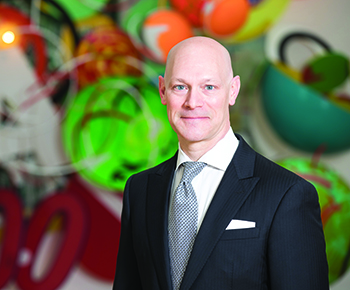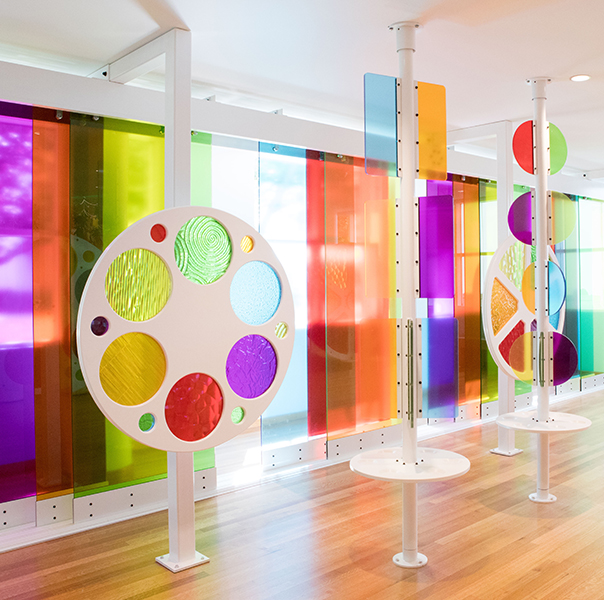::: Photos By Cat Max Photography :::
Seven years ago, Randall Suffolk came to Atlanta’s High Museum of Art with the goal of opening the museum’s doors to the city’s expanding and diverse population. Alongside the “old friends,” as he calls the pieces that have long been on display, he revitalized the museum with new art installations, new artists, and new visions that reflected the city’s inhabitants.
“We want every walk of life, every color of the rainbow, coming to experience their museum,” he said recently in a room just off the museum’s courtyard where artisans and workers were constructing a sphere for the Joylanta exhibition. “Art encourages people to think critically about oneself and about the world around them. At the end of the day, they are all things that are going to make us better citizens and, hopefully, to strengthen society at large.”
The High’s visitor profiles have drastically changed in the past seven years. Prior to 2015 the non-white visitors accounted for just fifteen percent of the total. Last year that figured topped fifty-seven percent. At the same time, exhibitions featuring women artists, artists of color and LGBTQ+ artists rose to over fifty percent of the total presentations.
“We’ve doubled down to engage the next two generations,” Suffolk said. “We’ve had great success in changing our end users, for lack of a better word.”
Figures put out by the High show that nearly seven out of ten visitors are under the age of 55 and an astonishing fifty-five percent are under the age of 35. Memberships in the museum have increased by twenty-seven percent, even with the pandemic, to 33,000 households.

Suffolk immediately reduced the admission price to an affordable $18.50 and implemented the Second Sunday program, which provides free admission all day. Before the advent of this popular program, High visitors numbered an average of 1,650 on Sundays. Second Sunday now averages around 4,300 visitors.
And that doesn’t count the 50,000 school kids that come on tours with their schools.
Many schools in the Southern Crescent take advantage of the High’s Art Access program that pays for all the kids’ and teachers’ admission, and even kicks in for transportation costs.
Flashay Benford is a Media Specialist at Stockbridge High School who took her art studies students on a visit to the High during Black History Month.
“Some of the students had never left Henry County. So, this was an opportunity for them to have a cultural experience. They could learn about the world outside their world,” she said. “We went specifically for Black History Month so our students could see some of the black artists on display.”
Latiefa Hairston echoed the same experience for her eight grade students from ASAP Gender Academy at Bear Creek Elementary School.
“It exposed them to artists who look like people they ride MARTA with,” she said. Her students were fascinated by El Anatsui, a Ghana artist who creates objects with things such as aluminum cans and pull tabs.
Another artist that grabbed her kids’ attention was Vik Muniz, a Brazilian artist who produced images of the Mona Lisa in peanut butter and jelly. “They were fascinated by some of the art, especially the Brazilian artist. One student told me he didn’t know there were black people in Brazil,” said Hairston.
“We think it is really important to give these children an opportunity to come into contact with not only experiences but conversations that are bigger than themselves,” said Suffolk.
“I teach the classics, but I want the kids to see modern artists. These are artists the kids can relate to,” said Elise Gomez, the k-5 Visual Arts Lead at Arnold Elementary School.
Some of her students came up and hugged Gomez as they were heading home. “They said, ‘Thank you for bringing us!’ It was one of those feel-good moments that makes being a teacher worth it.”
But art for art’s sake is not the only driving force for teachers to expose their students to the High.
“Art teaches a lot of skills that can be applied to many areas of life. It teaches patience and perseverance. It helps them to look at the world around them,” said Ayaana Thompson, the 5th grade teacher at Lake Ridge Elementary School. “It is one thing to show them art in the classroom but when they leave the four walls of the school and see art in the museum, it is an entirely different experience.”
“Art builds a foundation for creative thinking. Jobs are asking for people who think outside the box, and having art in elementary school helps with this thinking,” said Gomez.
Art classes are one of the first victims of budget cuts, said Suffolk, who noted that the students host all kinds of kids, toddlers to seniors in high school. “Art is being more and more lost,” noted Hairston. “Often, they see no purpose in it.”
The new artists and exhibitions have changed the perception of the High as it has changed the audience of the museum. Where once it was thought that only the wealthy elite or highly educated people went to the High, recent studies reveal a dramatic shift in visitors. Today, some forty-four percent have less than a bachelor’s degree and about forty-two percent make less than $70,000 a year.
“People really drive these institutions. Without people, these are just fancy storage units with a retail component,” said Suffolk. “That is not what we want to be. That is not our mission.”
The mission of the High will continue to showcase new visions from emerging artists that will spark different conversations about who and what we are as a civilization. One recent exhibition was from Deana Lawson, whose photographs “challenges the conventional representations of Black identities and bodies,” according to the High’s description of her work.
Proving that a great artist does not have to go to art school or study the classical artists, George Voronovsky is a Ukranian refugee who settled in Florida, where he taught himself to make paintings executed on cardboard and figures in Styrofoam. He even made a film of constructing a rocket ship to the sun. The High displayed many of his works four decades after his death.
Suffolk said the museum strives to show a wide variety of art. The High is the first museum in the Southeast to offer “one of the most important collections of samurai armor outside of Japan.” Running through September, the exhibit features more than one hundred fifty helmets, swords, and other objects, including complete sets of armor, that span almost nine centuries.
The generations to come in Atlanta will naturally influence the conversations art generates and contribute to the innovative looks and artists that mirror the community at large.
“We believe there is something ultimately very powerful and super generative about being a place where the richest of the rich can come together with the poorest of the poor, where every color and range of the LGBTQ+ rainbow can come together with every color of the ethnicity rainbow,” said Suffolk. “We want the High to be a place where all of Atlanta can come together.”


